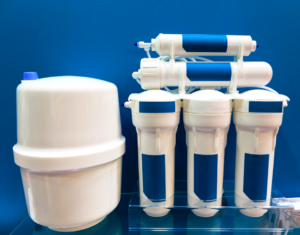
Looking to learn more about reverse osmosis? This Lemont water conditioning company has you covered.
How Do Reverse Osmosis Systems Work?
In terms of operation, reverse osmosis systems are fairly straightforward. They consist of a series of filters, each of which has different responsibilities throughout the filtering process. While these systems can possess up to 9 filters in total, they are generally separated into three categories: pre-filter, membrane filter, and post-filter. We’ll discuss the specifics of each filter category below.
Pre-filter
The pre-filter is responsible for removing large contaminants such as sand, dirt, and soot. It cleanses water so as to remove wear and tear from the filters that follow. Generally speaking, the pre-filter will see more action when combined with a well water supply than it will when combined with a municipal water supply.
Membrane Filter
The membrane filter is the key filter in the reverse osmosis system. It removes essentially every contaminant from the water supply, including chemicals, minerals, bacteria, and otherwise. Some of the specific contaminants removed by the membrane filter include arsenic, lead, iron, manganese, calcium, and coliform bacteria.
Post-filter
The post-filter is somewhat like the janitor of the reverse osmosis system. It cleans up any mess that was left behind by the pre-filters and membrane filters. While it doesn’t catch every contaminant within the water supply, it comes very close, helping to produce water that’s noticeably pure and smooth.
The Benefits of Reverse Osmosis
There is one primary benefit of reverse osmosis: pure, clean water that is as smooth and as drinkable as possible. Reverse osmosis water is not only void of minerals and chemicals, but of bacteria as well. As such, it tastes great and allows you to cook without the influence of unwanted contaminants.
The Limitations of Reverse Osmosis
On a residential level, reverse osmosis systems have two limitations. They include the following.
Not Designed to Accommodate Large Water Supplies
Simply put, the reverse osmosis process is somewhat inefficient. For every gallon of water that’s purified by a reverse osmosis system, there are substantial amounts of water that are disposed of by it.
As such, many homeowners find that reverse osmosis systems do a poor job of accommodating a large water supply. For this reason, they’re typically used as specialty systems, providing enough purification for drinking water purposes, but not enough purification for showering and cleaning purposes.
Removes Vital Minerals
Because reverse osmosis systems remove essentially all contaminants existing within a water supply, they end up removing the beneficial contaminants in addition to the detrimental contaminants. Some of the beneficial contaminants they remove include calcium, magnesium, and iron, which are all vital to a healthy diet.
One thing to note is that there are plenty of other sources where you can obtain these minerals. In fact, there are even supplements available in pill form. As such, even if you use a reverse osmosis system, you shouldn’t have much trouble getting adequate amounts of these minerals in your diet.
Utilize the Services of a Lemont Water Conditioning Company
Interested in installing a reverse osmosis system? Looking to utilize the services of a Lemont water conditioning company? If so, DuPage Water Conditioning has you covered.
Our team has installed reverse osmosis systems in a number of homes throughout the Lemont area. Regardless of the size of your water supply, we can accommodate you.
Contact us today to schedule an appointment!
